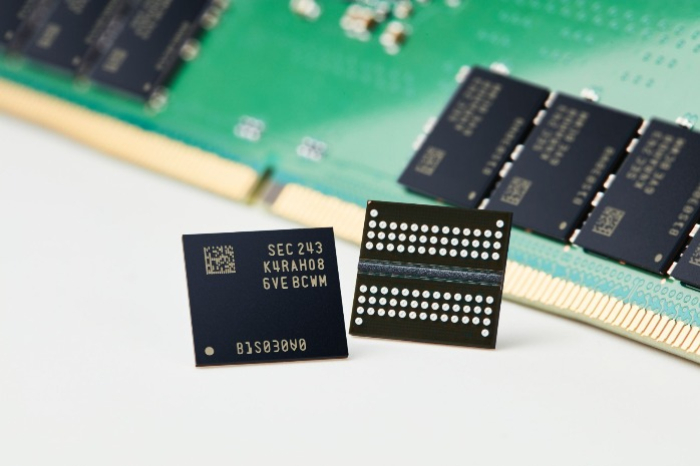Korean chipmakers
DRAM contract prices rebound after 27 months on rising demand
The price gain will continue into 2024 on the consumer electronics market recovery, sources say
By Nov 01, 2023 (Gmt+09:00)
2
Min read
Most Read
LG Chem to sell water filter business to Glenwood PE for $692 million


KT&G eyes overseas M&A after rejecting activist fund's offer


Kyobo Life poised to buy Japan’s SBI Group-owned savings bank


StockX in merger talks with Naver’s online reseller Kream


Meritz backs half of ex-manager’s $210 mn hedge fund



DRAM contract prices rebounded for the first time in more than two years last month amid the recovery in the consumer electronics market.
The price gain will continue next year as demand for high-performing DRAM chips, such as Low-Power Double Data Rate (LPDDR) for smartphones and DDR for computers, is rising and digital device manufacturers’ DRAM inventories have decreased, industry sources said.
The contract price of DDR4 8Gb 2133MHz, DRAM widely used for PCs, jumped 15.4% on-month to $1.5 in October, according to market data provider TrendForce's memory and storage division DRAMeXchange on Wednesday.
It was the first contract price gain in 27 months, since July 2021 when it rose 7.89%. The October increase is the largest since it logged 26.7% in April 2021.
The contract price for DDR5 16Gb SO-DIMM, a high-capacity module for laptops, also rose 11.5% on-month to $33 per unit in October.
DRAMs for smartphones are also expected to show hikes in contract prices. Fourth-quarter contract prices for mobile DRAMs are poised to see an increased quarterly rise of 13-18%, according to a TrendForce report last week.
The contract prices for NAND Flash will also increase, with prices of eMMC and UFS forecast to climb 10-15% in the fourth quarter, the report said.
The quarterly rise can be attributed to several factors, such as Samsung Electronics Co.'s production cuts and Micron Technology Inc. rolling out price hikes of more than 20%. These have laid the foundation for industry-wide confidence in price increases, according to the report.
Further, demand during the second half of this year has been boosted by catalysts like Huawei Technologies Co.'s new smartphone series Mate 60, which has prompted other Chinese smartphone brands to expand their production targets, the report added.
The DRAM oversupply of more than two years is coming to an end, and smartphone makers gearing up to launch premium products are accepting price increases from DRAM chip suppliers like Samsung Electronics and SK Hynix Inc., the world’s two largest memory chipmakers, industry sources said.
The upward trend in the contract prices will continue for a while into next year, they added.
Stock prices of Korean chipmakers climbed on Nov. 1 on news of the DRAM contract prices rebound. Samsung's shares rose 2.54% to finish at 68,600 won ($50.5), while SK Hynix's increased 3.44% to close at 120,300 won.
Write to Jeong-Soo Hwang at hjs@hankyung.com
Jihyun Kim edited this article.
More to Read
-
 Korean chipmakersSamsung showcases HBM3E DRAM, automotive chips
Korean chipmakersSamsung showcases HBM3E DRAM, automotive chipsOct 21, 2023 (Gmt+09:00)
3 Min read -
 Korean chipmakersSK Hynix pins high hopes on specialty DRAM for AI use: CEO
Korean chipmakersSK Hynix pins high hopes on specialty DRAM for AI use: CEOOct 10, 2023 (Gmt+09:00)
3 Min read -
 Korean chipmakersSamsung set to keep supremacy in low power DRAM with game changer
Korean chipmakersSamsung set to keep supremacy in low power DRAM with game changerSep 26, 2023 (Gmt+09:00)
2 Min read -
 Korean chipmakersHBM market to nearly double; next-gen DRAM to revive demand: KIW
Korean chipmakersHBM market to nearly double; next-gen DRAM to revive demand: KIWSep 11, 2023 (Gmt+09:00)
4 Min read -
 Korean chipmakersSK Hynix leads DRAM industry’s Q2 revenue rebound, retakes No. 2 spot
Korean chipmakersSK Hynix leads DRAM industry’s Q2 revenue rebound, retakes No. 2 spotAug 25, 2023 (Gmt+09:00)
2 Min read
Comment 0
LOG IN


